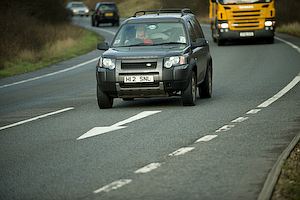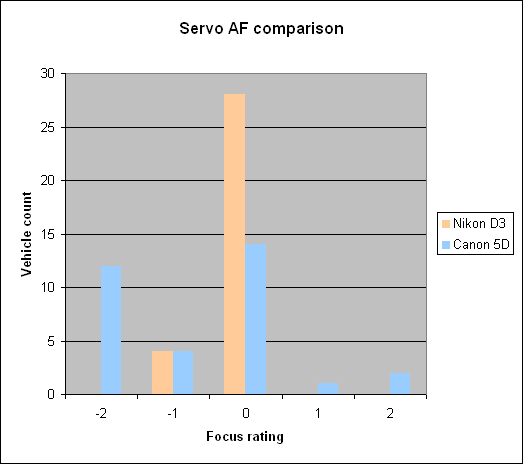Up to Nikon D3 index | Up to Canon 5D index

I stood beside the slip road coming off junction 12 of the M3 motorway near Allbrook. There was a frequent, but not continuous, stream of traffic coming towards me. Having previously driven it, I estimated that the cars were probably going about 40 MPH and the lorries about 30 MPH.
The cameras were fitted with their respective professional grade 70-200mm f/2.8 lenses set at 200mm with image stabilisation in its normal mode. They were used on aperture priority at f/2.8 and ISO was adjusted to give a shutter speed in the 1/2500 to 1/8000 sec region.
The Nikon was in its Continuous AF servo mode and the Canon in its AI servo mode. In these modes the cameras attempt to lock onto the subject and predictively adjust the focus to maintain the lock. All custom options related to focussing were left at their default settings.
The central AF point only was used. I pointed it at the bonnet of each vehicle as soon as I was able to do so - usually slightly earlier than the position of the yellow lorry above - and then tracked the front of the vehicle until its front reached the start of the white arrow painted on the road. I then pressed the shutter.
I then immediately switched to tracking the next vehicle where practicable. This resulted in some variation in the length of time for which each vehicle was tracked before pressing of the shutter.
The photos were developed in Adobe Lightroom, including sharpening to 100% at radius 1, and then assessed for accuracy of focus
when viewed at 100%. The following rating code was used:

The results are shown in the graph:
All the photos from both cameras would be quite usable, unless one wanted to crop in tight, in which case those rated ±2 would not be satisfactory.
Clearly, the D3 did a much better job than the 5D, as one might expect given that it is Nikon's top-of-the-range professional camera and, with a shooting speed up to 11 fps, is clearly intended to suit action photography. The 5D is only a prosumer model which is more oriented towards landscape and studio work. The results suggest that the 5D may have been over-predicting the speed of the vehicles.
A separate test I did indoors using one-shot AF in a dark corner under a table showed that the D3 was better at achieving focus on dimly lit subjects than the 5D, but I did not quantify this.
Peter Facey, Winchester, England
20080204 originated